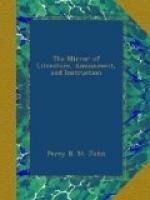43. The Lady in St. Swithin’s Chair from vol. i. Waverley.—Sir W. Beechey.—We confess ourselves far from pleased with this picture. There is a want of freedom in it which is any thing but characteristic of the incident which it is intended to portray.
56. The Spanish Posado.—D. Wilkie.—We must describe this picture in the words of the catalogue:—
This represents a Guerrilla council of war, at which three reverend fathers—a Dominican, a monk of the Escurial, and a Jesuit, are deliberating on some expedient of national defence, with an emissary in the costume of Valencia. Behind them is the posadera, or landlady, serving her guests with chocolate, and the begging student of Salamanca, with his lexicon and cigar, making love to her. On the right of the picture, a contrabandist of Bilboa enters, upon his mule, and in front of him is an athletic Castilian armed, and a minstrel dwarf, with a Spanish guitar. On the floor are seated the goatherd and his sister, with the muzzled house-dog and pet lamb of the family, and through the open portal in the background is a distant view of the Guadarama mountains—It is next to impossible for us to do justice to the diversified character of this picture. The deliberation of the fathers, and the little bit of episode between the landlady and student are extremely interesting.
(To be continued.)
* * * * *
SPITTLE-FIELDS, AND WEAVING IN FORMER DAYS.
(For the Mirror.)
Stowe says, “On the east side of the churchyard of St. Mary Spittle, lyeth a large field, of old time called Lolesworth, now Spittle-Field, which about the year 1576, was broken up for clay to make bricke; in digging thereof many earthen pots called urnae, were found full of ashes and the bones of men, to wit of the Romans that inhabited here. For it was the custom of the Romans to burne their dead, to put their ashes in an urne, and then bury the same with certain ceremonies, in some field appointed for the purpose neere unto their city. Every one of these pots had in them (with the ashes of the dead) one piece of copper money, with an inscription of the emperor then reigning. Some of them were of Claudius, some of Vespasian, some of Nero, &c. There hath also been found (in the same field) divers coffins of stone, containing the bones of men; these I suppose to be the bones of some speciall persons, in the time of the Brittons, or Saxons, after that the Romans had left to govern here.




